The cradle of the Sri Lanka Air Force
July 24, 2021
The cradle of the Sri Lanka Air Force
Dishan Joseph
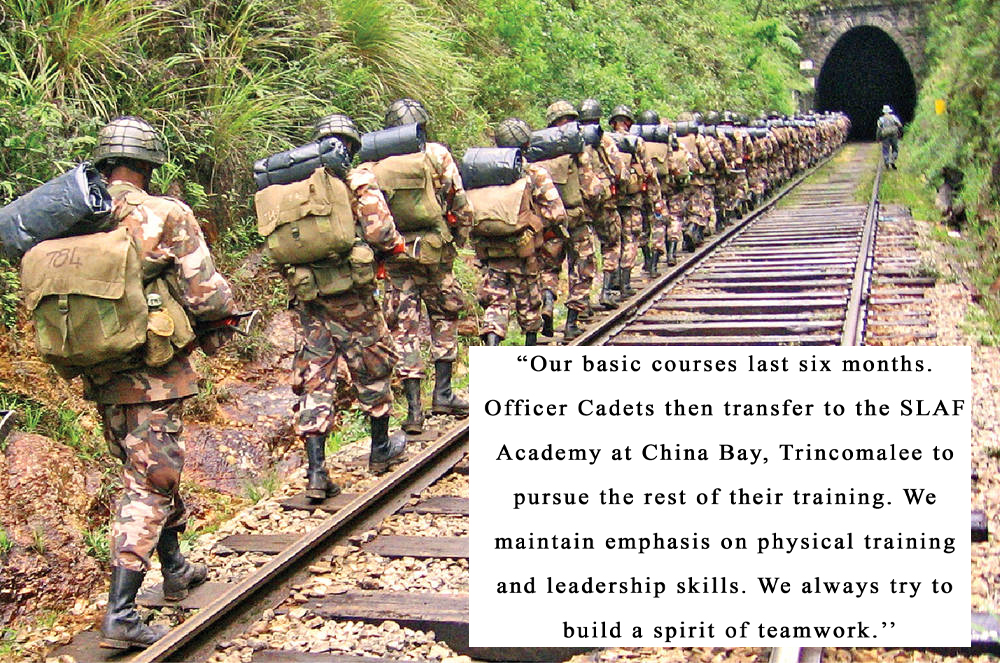 The salubrious green hills of Diyatalawa are embellished with natural beauty. For decades, this hill station has been a garrison town, first discovered and established by the Royal Army in 1859, and subsequently enhanced by the Royal Air Force. The pioneer British military officers who appreciated the significance of this area, bestowed with diverse terrain, realised its strategic importance for ground combat training. Diyatalawa has an amazing terrain layout including ridges, valleys, ravines, hills and waterways. The Combat Training School (CTS) of the Sri Lanka Air Force has a beautiful and inspiring history.
The salubrious green hills of Diyatalawa are embellished with natural beauty. For decades, this hill station has been a garrison town, first discovered and established by the Royal Army in 1859, and subsequently enhanced by the Royal Air Force. The pioneer British military officers who appreciated the significance of this area, bestowed with diverse terrain, realised its strategic importance for ground combat training. Diyatalawa has an amazing terrain layout including ridges, valleys, ravines, hills and waterways. The Combat Training School (CTS) of the Sri Lanka Air Force has a beautiful and inspiring history.
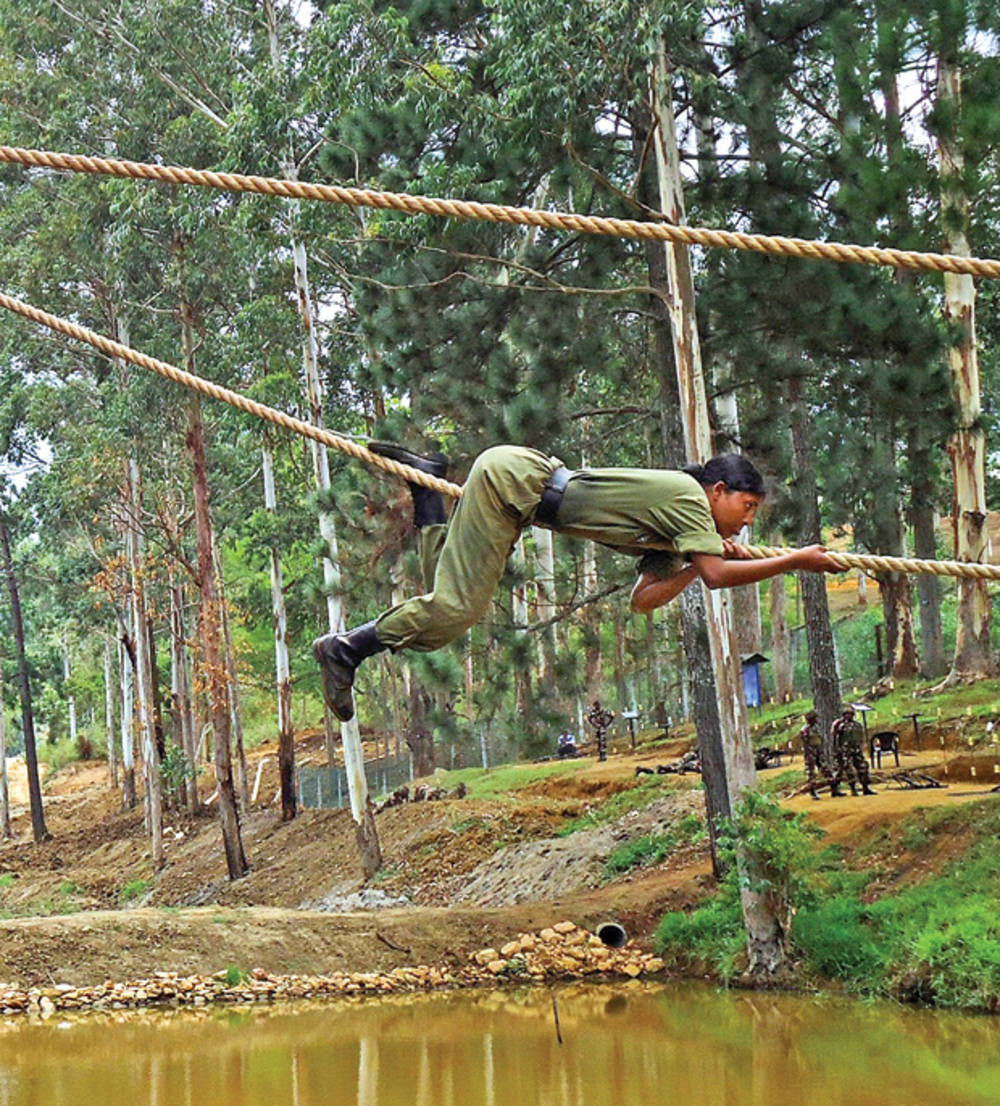 The British Army had fought the Dutch in South Africa in 1900. The land area in Diyatalawa would soon be used as a prisoner-of-war camp during the Boer War, where nearly 5,000 prisoners were held on the instructions of the then Governor General of Ceylon Sir Ridgeway. The British Army had surveyed this area and the Public Works Department (PWD) was tasked with building a massive camp to facilitate the Boer prisoners. The first batch of prisoners arrived on August 9, 1900. Later on, the Royal Army extended the camp during the period of the Second World War when German prisoners were also held here. When Ceylon gained Independence in 1948, the British handed over their camp to the Ceylon Army. The Army released a part of this large base to the Royal Ceylon Air Force, and this section was known as Stable Hill. The horses used by the Army were once kept here. The Royal Ceylon Air Force (RCYAF) established a detachment at Stable Hill on October 15, 1952. In May 1952, the first intake of Ceylonese recruits of the Royal Ceylon Air Force commenced their training at the RCYAF Katunayake. Subsequently, Flight Lieutenant J.V. Howard was assigned as the first Commanding Officer of Diyatalawa. During the early days, training was confined to drill, fitness and weapons handling. The cross country “map marches” were conducted for recruits covering Gurutalawa, Welimada and Black Pool, sometimes continuing to the Ambewela Railway Station.
The British Army had fought the Dutch in South Africa in 1900. The land area in Diyatalawa would soon be used as a prisoner-of-war camp during the Boer War, where nearly 5,000 prisoners were held on the instructions of the then Governor General of Ceylon Sir Ridgeway. The British Army had surveyed this area and the Public Works Department (PWD) was tasked with building a massive camp to facilitate the Boer prisoners. The first batch of prisoners arrived on August 9, 1900. Later on, the Royal Army extended the camp during the period of the Second World War when German prisoners were also held here. When Ceylon gained Independence in 1948, the British handed over their camp to the Ceylon Army. The Army released a part of this large base to the Royal Ceylon Air Force, and this section was known as Stable Hill. The horses used by the Army were once kept here. The Royal Ceylon Air Force (RCYAF) established a detachment at Stable Hill on October 15, 1952. In May 1952, the first intake of Ceylonese recruits of the Royal Ceylon Air Force commenced their training at the RCYAF Katunayake. Subsequently, Flight Lieutenant J.V. Howard was assigned as the first Commanding Officer of Diyatalawa. During the early days, training was confined to drill, fitness and weapons handling. The cross country “map marches” were conducted for recruits covering Gurutalawa, Welimada and Black Pool, sometimes continuing to the Ambewela Railway Station.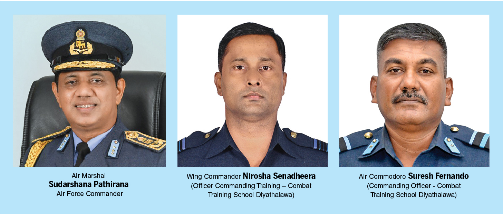
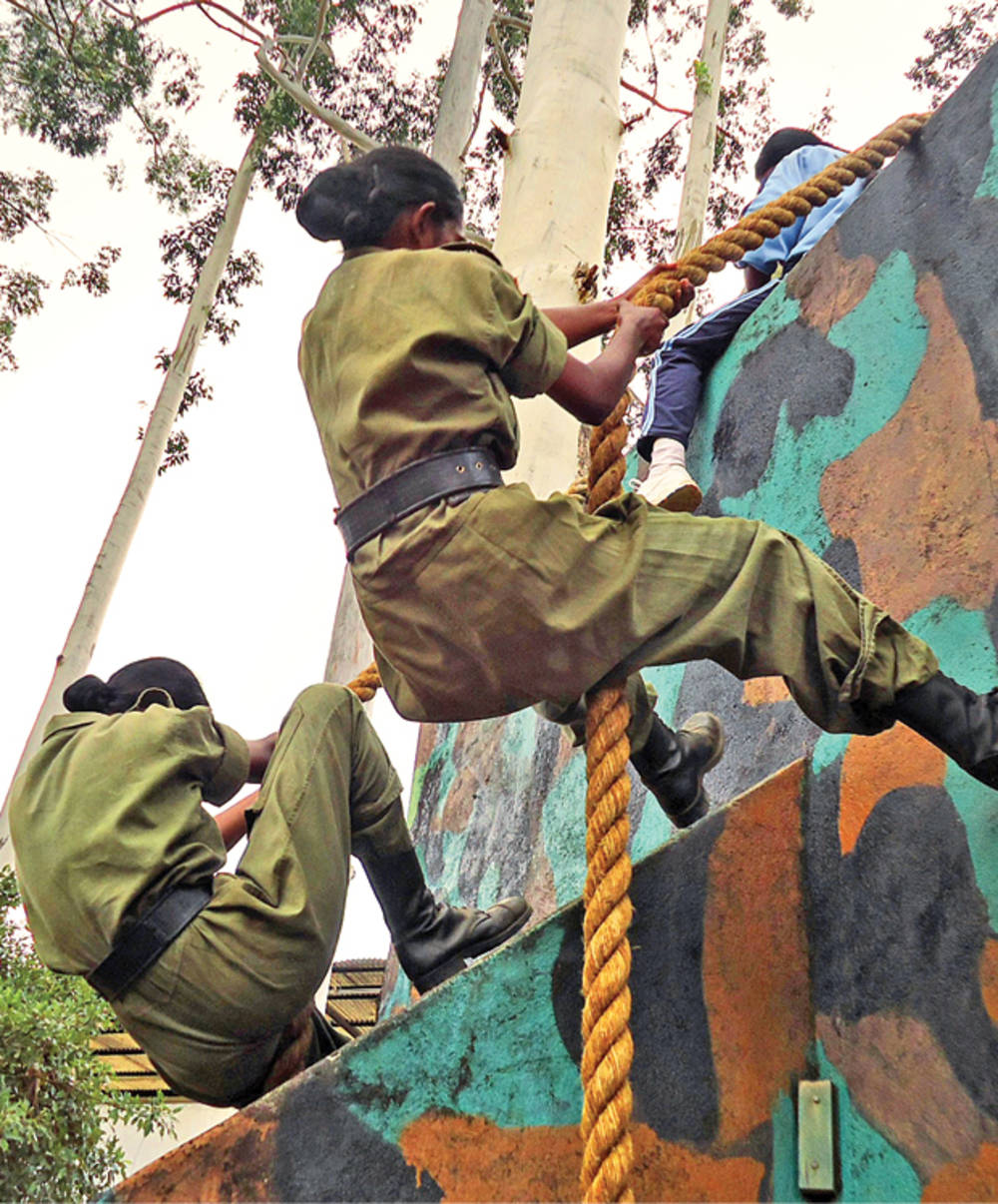 It is recorded that in 1959, Squadron Leader P.D. Lee had introduced a systematic training process during his tenure as Commanding Officer. Flight Sergeant Anderson had built the agility and assault course. The training of officers and airmen was planned by them and carried out by the Chief Instructor. Officer intakes consisted of three categories - direct entry, cadet entry and professional entry. New recruits wore a khaki uniform and boots, and this uniform is worn to date. The first Officer Cadets course commenced on February 19, 1953. Later, the Training Wing was restructured and an officer was appointed as OCT- Officer Commanding Training.
It is recorded that in 1959, Squadron Leader P.D. Lee had introduced a systematic training process during his tenure as Commanding Officer. Flight Sergeant Anderson had built the agility and assault course. The training of officers and airmen was planned by them and carried out by the Chief Instructor. Officer intakes consisted of three categories - direct entry, cadet entry and professional entry. New recruits wore a khaki uniform and boots, and this uniform is worn to date. The first Officer Cadets course commenced on February 19, 1953. Later, the Training Wing was restructured and an officer was appointed as OCT- Officer Commanding Training.
I visited the Combat Training School, along with Squadron Leader Amila Wijesuriya to gain an insight into this magnificent training establishment, venerated by all officers as the “Cradle of the Air Force”. The present Commanding Officer is Air Commodore Suresh Fernando. This premier training school is where all the aspiring officers and airmen get their first taste of air force life, experience basic combat training and begin their careers. In recognition of the great service rendered by this training school, the President’s Colour was bestowed on the CTS on April 2, 2018.
In addition to the basic training courses, the CTS Diyatalawa conducts refresher courses for junior and senior 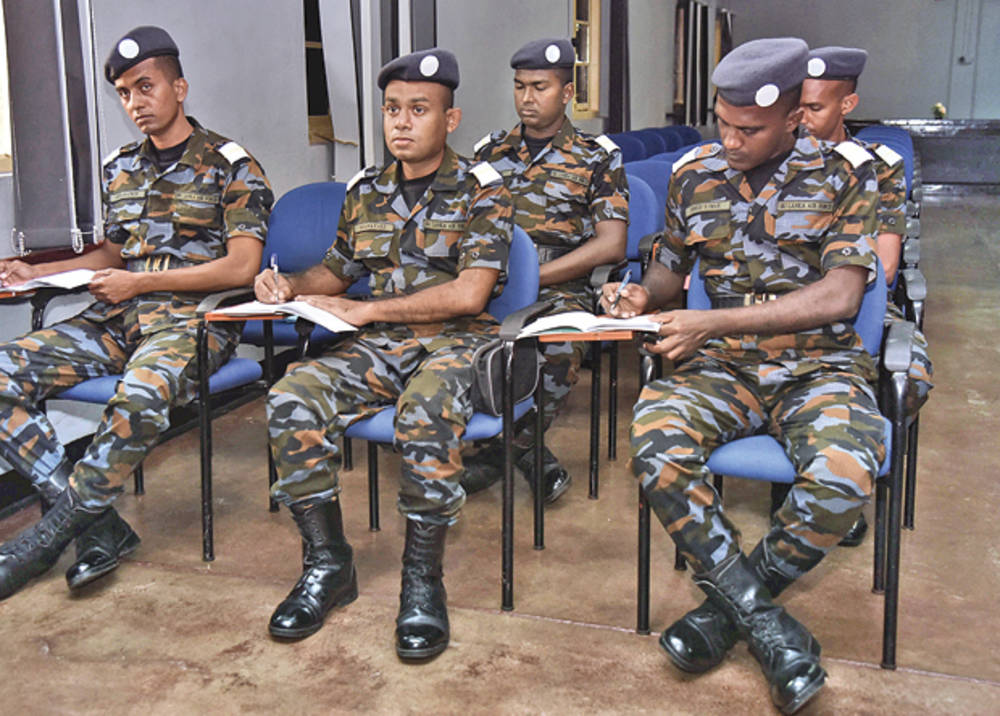 officers, drill instructors course, gunner instructors course, PT advanced course for instructors, advanced regiment officer course, and basic information technology course. The airfield defence and ground combat course is conducted for officers and airmen of the Bangladesh Air Force. We drove along the winding roads which were flanked by hills. The cool breeze drifted through the rows of tall pine trees. A squadron of officer cadets, were going through their drill process at the famous Bentley Parade Ground, under the watchful eyes of two Drill Instructors (DI). One of the DIs was wearing a white cross belt, which denoted his advanced training followed in London. His sharp clear voice resonated among the green hills. For all aspiring officer cadets and airmen, the DI is the “mentor” and probably their visual role model who manifests an immaculate uniform, rigid posture, brisk walk and unblemished discipline. As I looked upon these rows of energetic young men, marching in close formation, I realised that in 30 years, one of them will surely rise to become the Air Force Commander. A few minutes later, a section of airwomen under training moved past us carrying their T-56 weapons, engaging in some form of field exercise. At present, training is conducted under four squadrons namely - officer training squadron, advanced training squadron, officer cadet training squadron and recruit training squadron. This massive responsibility is executed by the OCT. The incumbent OCT in Diyatalawa is Wing Commander Nirosha Senadheera, a dynamic officer.
officers, drill instructors course, gunner instructors course, PT advanced course for instructors, advanced regiment officer course, and basic information technology course. The airfield defence and ground combat course is conducted for officers and airmen of the Bangladesh Air Force. We drove along the winding roads which were flanked by hills. The cool breeze drifted through the rows of tall pine trees. A squadron of officer cadets, were going through their drill process at the famous Bentley Parade Ground, under the watchful eyes of two Drill Instructors (DI). One of the DIs was wearing a white cross belt, which denoted his advanced training followed in London. His sharp clear voice resonated among the green hills. For all aspiring officer cadets and airmen, the DI is the “mentor” and probably their visual role model who manifests an immaculate uniform, rigid posture, brisk walk and unblemished discipline. As I looked upon these rows of energetic young men, marching in close formation, I realised that in 30 years, one of them will surely rise to become the Air Force Commander. A few minutes later, a section of airwomen under training moved past us carrying their T-56 weapons, engaging in some form of field exercise. At present, training is conducted under four squadrons namely - officer training squadron, advanced training squadron, officer cadet training squadron and recruit training squadron. This massive responsibility is executed by the OCT. The incumbent OCT in Diyatalawa is Wing Commander Nirosha Senadheera, a dynamic officer.
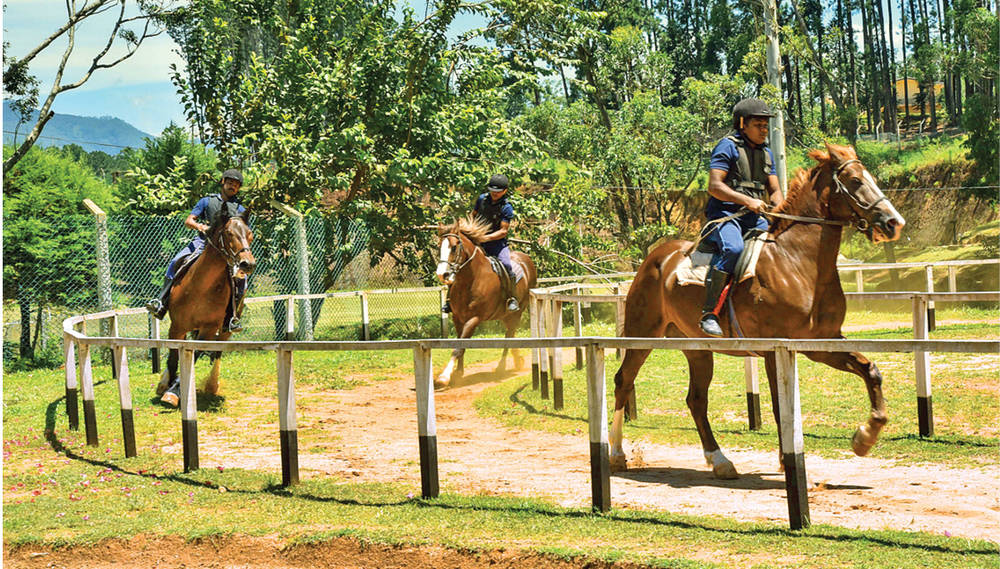 This 90-acre training complex has accommodation units (known as billets), a mess for cadets, library and swimming pool. A firing range teaches all officers and other ranks to shoot accurately from the standing, kneeling and prone positions. Officers of the SLAF Regiment gain advanced training in weapons, as they progress in their trade of Force Protection. The CTS Diyatalawa has another refreshing unit - a fully fledged riding school with robust horses. The majestic horses from Pakistan encourage the new riders to build confidence. The horses are duly groomed and exercised each day, under the supervision of a veterinary officer. I had the privilege of riding one of these amazingly strong horses, which was a very pleasant surprise. All SLAF recruits begin their day at 4 am and assemble for morning PT at 5 am. They engage in an assortment of lessons and military field craft. Each day ends at 10 pm. The strict Drill Instructors used to inspect each billet and maintain high standards.
This 90-acre training complex has accommodation units (known as billets), a mess for cadets, library and swimming pool. A firing range teaches all officers and other ranks to shoot accurately from the standing, kneeling and prone positions. Officers of the SLAF Regiment gain advanced training in weapons, as they progress in their trade of Force Protection. The CTS Diyatalawa has another refreshing unit - a fully fledged riding school with robust horses. The majestic horses from Pakistan encourage the new riders to build confidence. The horses are duly groomed and exercised each day, under the supervision of a veterinary officer. I had the privilege of riding one of these amazingly strong horses, which was a very pleasant surprise. All SLAF recruits begin their day at 4 am and assemble for morning PT at 5 am. They engage in an assortment of lessons and military field craft. Each day ends at 10 pm. The strict Drill Instructors used to inspect each billet and maintain high standards.
Commanding Officer Air Commodore Suresh Fernando said, “This is the premier training establishment of the SLAF. Our motto is Combat discipline through Training. Our basic courses last six months. Officer Cadets then transfer to the SLAF Academy at China Bay, Trincomalee to pursue the rest of 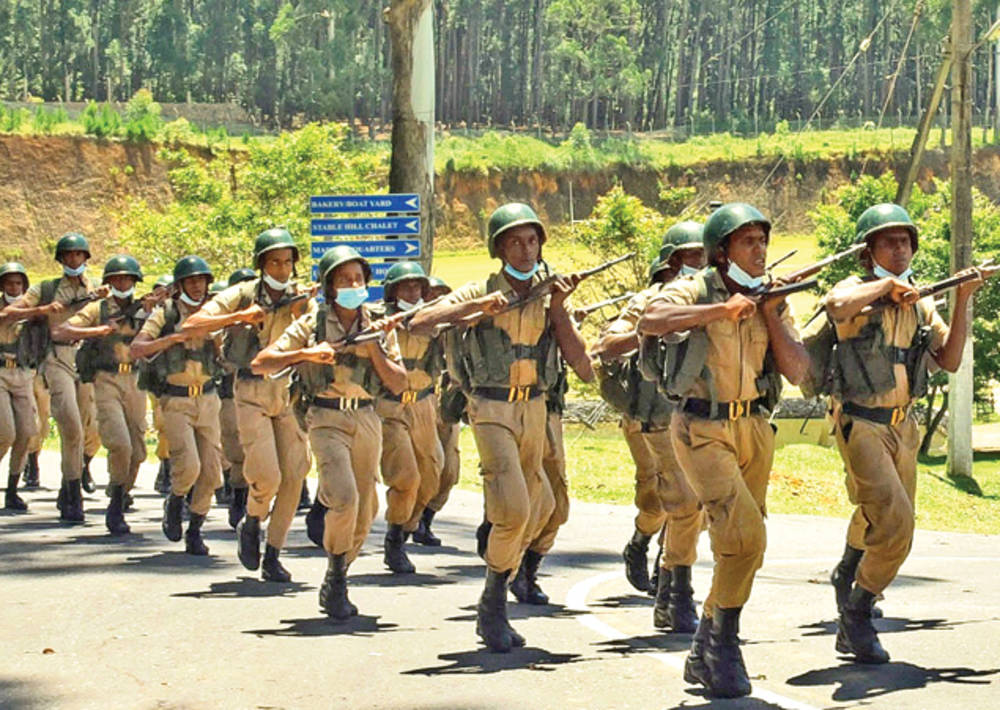 their training. We maintain emphasis on physical training and leadership skills. We always try to build a spirit of teamwork. Recruits do a long walk to Pattipola - a distance of 28 kilometres. This includes staying overnight for three days. Each recruit must carry a 25Kg pack and march through various terrains. The walk begins at first light around 5.30 am. This is a challenge but they complete this exercise. In addition, they do a nine-mile march, with their rucksacks. Towards the end of their training course, they engage in a 48-mile long walk, which usually must be done within eight hours. The recruitswalk from Stable Hill to Bandarawela, Welimada, Boralanda and return via Kirinda to the base. This tests their endurance and teamwork. At the end of the basic training, all SLAF personnel take part in a passing out parade that is full of ceremonial military traditions”. Our visit to Stable Hill was most rewarding. The Combat Training School in Diyatalawa does a sterling job of moulding disciplined and courageous men and women, who become the patriotic guardians of our nation’s skies.
their training. We maintain emphasis on physical training and leadership skills. We always try to build a spirit of teamwork. Recruits do a long walk to Pattipola - a distance of 28 kilometres. This includes staying overnight for three days. Each recruit must carry a 25Kg pack and march through various terrains. The walk begins at first light around 5.30 am. This is a challenge but they complete this exercise. In addition, they do a nine-mile march, with their rucksacks. Towards the end of their training course, they engage in a 48-mile long walk, which usually must be done within eight hours. The recruitswalk from Stable Hill to Bandarawela, Welimada, Boralanda and return via Kirinda to the base. This tests their endurance and teamwork. At the end of the basic training, all SLAF personnel take part in a passing out parade that is full of ceremonial military traditions”. Our visit to Stable Hill was most rewarding. The Combat Training School in Diyatalawa does a sterling job of moulding disciplined and courageous men and women, who become the patriotic guardians of our nation’s skies.
Courtesy - www.dailynews.lk